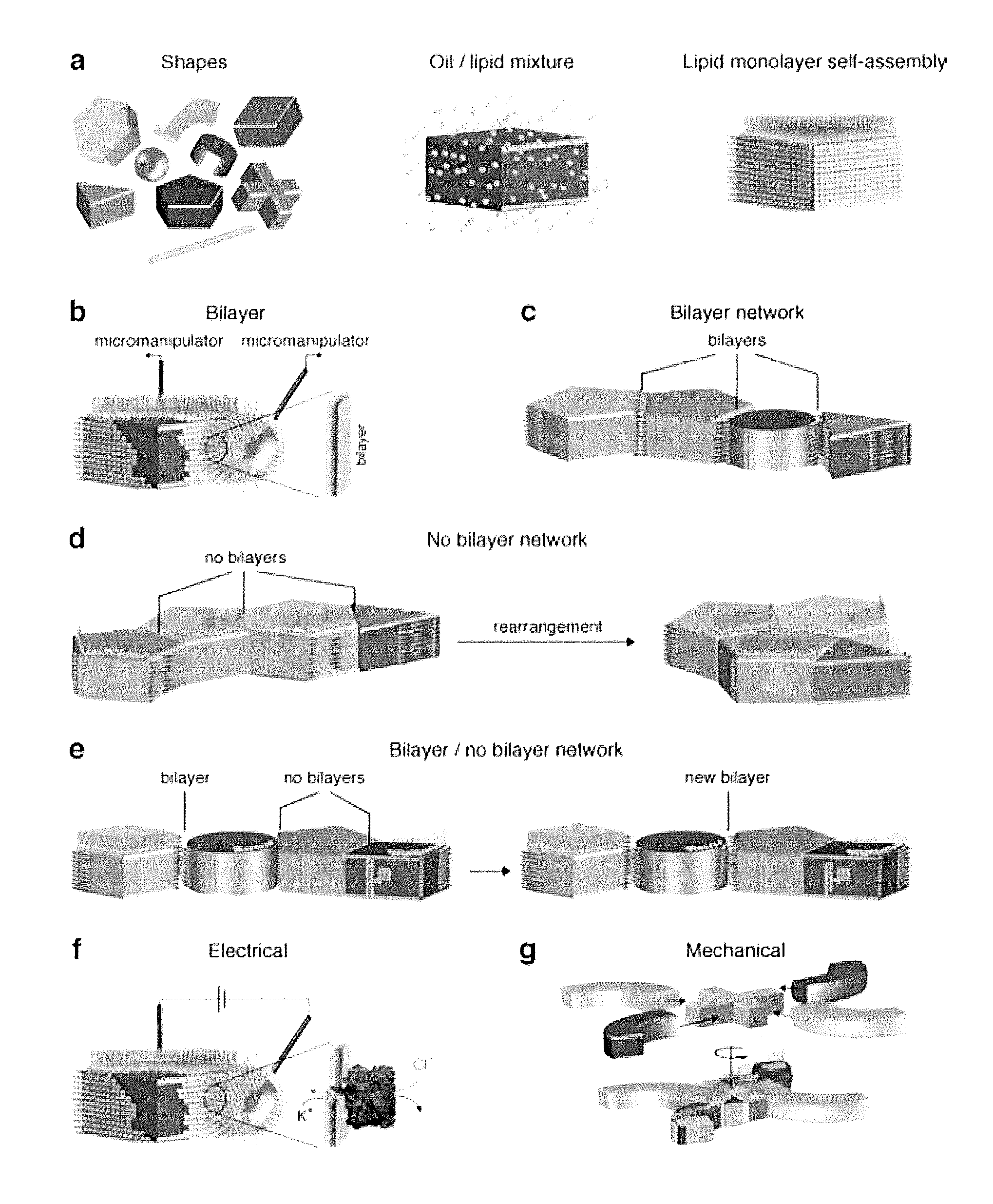Hydrogel network
a technology of hydrogel and network, applied in the field of hydrogel networks, can solve the problems of structural complexity and functional diversity of networks, and achieve the effects of reducing the number of contacts, reducing the number of ions, and facilitating the transport of ions through the network
- Summary
- Abstract
- Description
- Claims
- Application Information
AI Technical Summary
Benefits of technology
Problems solved by technology
Method used
Image
Examples
example 1
Bilayer Formation Between Hydrogel Shapes
[0363]The inventors supposed that two hydrogel objects, encased in lipid monolayers, brought close to each other with a micromanipulator, would form a bilayer at the interface, which could be functionalized by the incorporation of transmembrane pores (FIG. 1b,f). Lipid monolayers were formed on the surfaces of shaped hydrogel objects by immersion in a lipid / oil mixture (FIG. 2). When two lipid-coated hydrogel surfaces were brought together, a bilayer indeed formed between them, which was detected by an increase in specific capacitance to the anticipated value (FIG. 4). Assuming a circular bilayer, the specific capacitance of the bilayers formed between two hydrogels was determined to be 0.56±0.14 μF cm−2 (average±S.D., n=11). This value is in good agreement with the reported value of ˜0.65 μF cm−2 (Gross, L. C., Heron, A. J., Baca, S. C. & Wallace, M. I. Langmuir 27, 14335-14342 (2011)).
[0364]Initially, a hydrogel sphere was used to form bila...
example 2
Hydrogel-Hydrogel Bilayer Networks
[0367]Agarose shapes, coated with a lipid monolayer (10 mg mL−1 DPhPC in hexadecane), were assembled manually (by using a stainless steel needle) to form networks that featured bilayers in series and in branched structures (FIG. 6). Bilayers delimited the individual objects, because no dye transport was observed between them (FIG. 6a,b). Bilayer networks with altered patterns could be constructed by simple manual manipulation of the hydrogel shapes with a needle (FIG. 6c-e). The bilayer networks formed by the millimeter-sized hydrogel shapes was stable for up to 48 h (n=19).
example 3
Hydrogel Assemblies without Bilayers
[0368]Hydrogel shapes were also used as building blocks to construct self-assembling networks to enable communication over macroscale (centimeter) distances. When agitated or mechanically stirred in hexadecane (with or without lipids), the hydrogel shapes formed arbitrarily arranged networks (FIG. 7a, FIG. 8). In this case, no lipid bilayers remained at the hydrogel-hydrogel interfaces after the assembly process. The networks could be altered by manipulation with a steel needle to form assemblies with desired arrangements of the hydrogel objects. Displacement of the lipid bilayer between two hydrogel objects maximizes the area of contact between the hydrophilic surfaces to form a thermodynamically stable configuration (Du, Y., Lo, E., Ali, S. & Khademhosseini, A. Proc Natl Acad Sci USA 105, 9522-9527 (2008)).
PUM
| Property | Measurement | Unit |
|---|---|---|
| Length | aaaaa | aaaaa |
| Length | aaaaa | aaaaa |
| Fraction | aaaaa | aaaaa |
Abstract
Description
Claims
Application Information
 Login to View More
Login to View More - R&D
- Intellectual Property
- Life Sciences
- Materials
- Tech Scout
- Unparalleled Data Quality
- Higher Quality Content
- 60% Fewer Hallucinations
Browse by: Latest US Patents, China's latest patents, Technical Efficacy Thesaurus, Application Domain, Technology Topic, Popular Technical Reports.
© 2025 PatSnap. All rights reserved.Legal|Privacy policy|Modern Slavery Act Transparency Statement|Sitemap|About US| Contact US: help@patsnap.com



